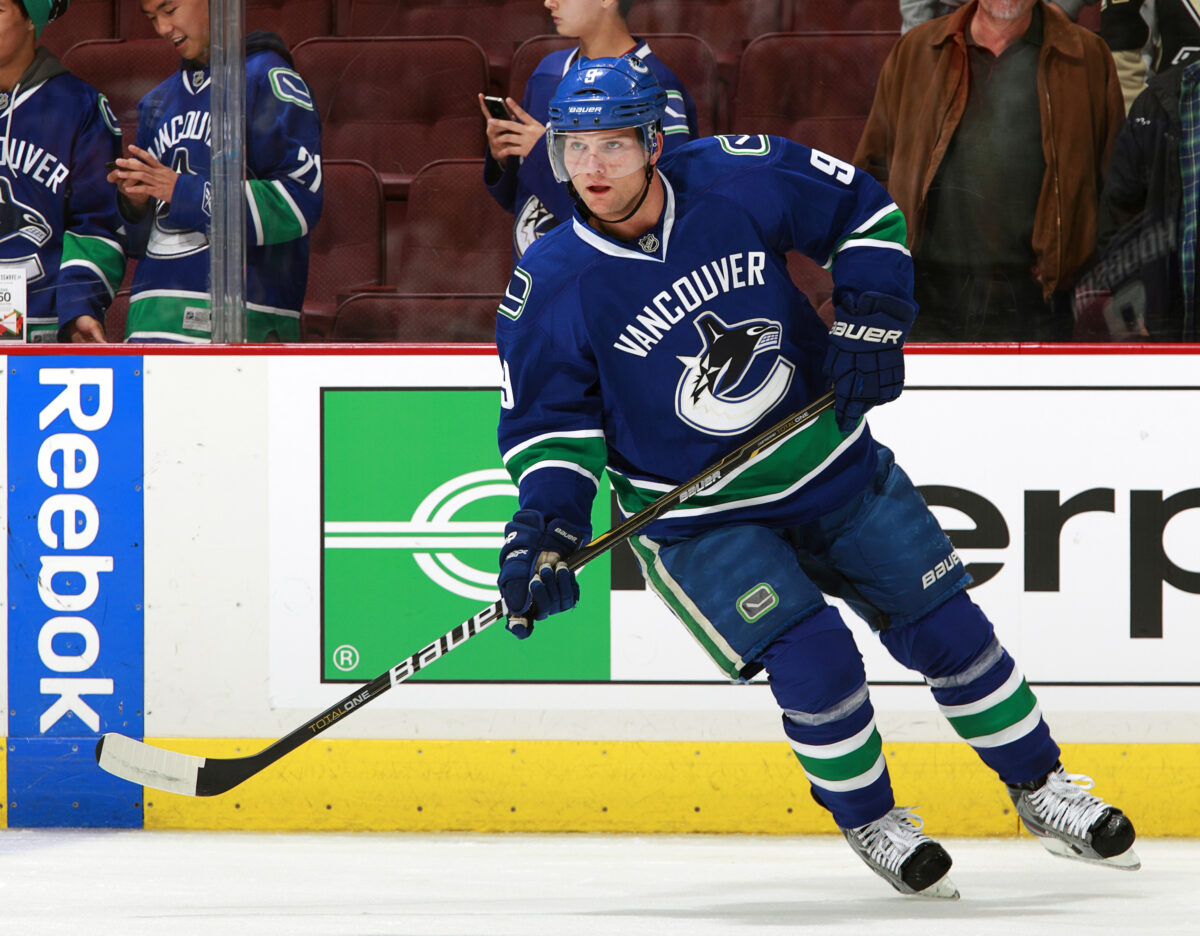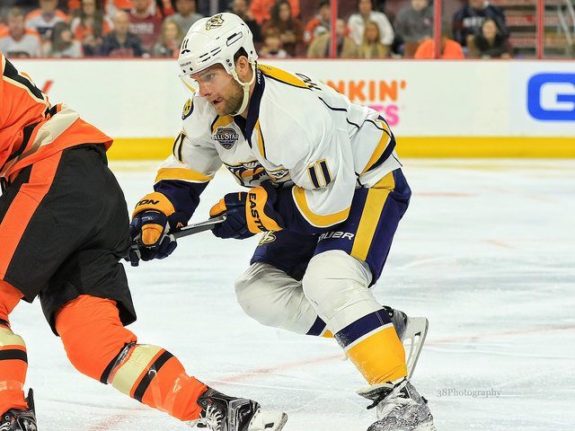The Vancouver Canucks have had some rough luck with high picks. They narrowly missed out on selecting Gilbert Perrault first overall in their inaugural draft, traded away Rick Vaive, Bill Derlago, and Cam Neely before they became stars, and whiffed on several top picks in the late 1980s and 1990s. So when top-prospect Cody Hodgson began to flare out only a few years into his young career, it seemed like another example of the franchise being cursed.

But Hodgson was far from being just another failed draft pick. While a public feud publicly and privately went on between the talented prospect and the Canucks’ coach and general manager, an undiagnosed condition was slowly eroding his ability to play hockey. A change of scenery saw him escape the intense criticisms in Vancouver, but with his medical issues still a mystery, his new team quickly gave up on him too. Yet when he finally discovered what was causing him so much distress, it was a wonder he made it to the NHL in the first place.
Canucks Look for Leadership and Character
From 2000-07, the Canucks were one of the NHL’s top teams, finishing with at least 100 points in three separate seasons. Yet playoff success did not follow. In their five playoff appearances in that span, they made it past the first round just twice. Then came the 2007-08 season, where Vancouver dropped to 21st in the league, their worst finish in nearly a decade. The one redeeming factor was that the team got the 10th overall pick in the upcoming draft, and with several of their stars starting to decline, it was a great chance to add a jolt of talent to the struggling franchise.
The 2008 Draft was hailed for having several skilled defencemen available in the top half of the first round, but the Canucks already had their blue line set for the future. They needed a leader, and there wasn’t a better option available than Hodgson. A highly-touted forward with the Ontario Hockey League’s (OHL) Brampton Battalion, he was hailed for his intelligence and character, which was on full display at the U18 World Juniors with Team Canada, where he served as team captain and led the team with 12 points in seven games.
Hodgson seemed like the perfect fit for the Canucks. He was already drawing comparisons to Trevor Linden, one of the Canucks’ best leaders, and was coached by Pat Quinn at the U18s, who filled a variety of roles with Vancouver from 1987-1998. With current captain Markus Naslund and alternate captain Brendan Morrison at the end of their contracts and unlikely to be re-signed, the team had a major leadership gap. Hodgson wouldn’t fill that right away, but there was no doubt in anyone’s mind that he would be a big part of the team’s future.
First-year general manager Mike Gillis heaped praise onto his newest addition, commenting to TSN “[Hodgson’s] a great young player. He’s got terrific leadership skills. He fits into our plans as soon as he’s able to make our hockey club. We expect to give him a great opportunity and we’ll see what he does with it.” Even if his potential put him in the bottom six of an NHL roster, his other skills immediately made him the Canucks’ top prospect.
Hodgson’s Rift With the Canucks
Hodgson’s title as top prospect didn’t last long, however. He had a breakout season with the Battalion in 2008-09, scoring 43 goals and 92 points, plus another 31 points in the playoffs. Even more impressive was his role with Team Canada at the 2009 World Junior Championship, where he led the team with 16 points en route to capturing a gold medal. Many expected him to make the team the following season, but he never got the chance, as an off-season back injury prevented him from partaking in Canucks training camp.
Initially, Hodgson’s back injury was diagnosed by the Canucks’ medical staff as a herniated disk and he was expected to make a quick recovery, but after months of pain and treatment, it was finally revealed to be a torn muscle. It wasn’t until he sought another medical opinion that it was discovered he had done it in a twisting exercise. However, his desire to seek other medical opinions irked head coach Alain Vigneault as he claimed Hodgson was simply shifting blame for a poor preseason.
It didn’t matter that the Canucks were wrong, nor did it matter others, including Daniel and Henrik Sedin, had public disagreements with Vigneault. Not even a great start to the 2011-12 season, where Hodgson scored 33 points in 63 games and was in the running for the Calder Trophy, could repair the fractured relationship between the team’s top prospect and their general manager. A year of rehab and training had caused the fans and team to see him as a prima donna, a complainer, and unfit for their team, no matter what he did.
Related: Canucks’ Rocky Relationship With Hodgson Led to Shocking Trade
The situation came to a head on Feb 27, 2012, when the Canucks dealt Hodgson, along with defenceman Alex Sulzer, to the Buffalo Sabres for Zack Kassian and Marc-Andre Gragnani. The move was panned almost universally; only Gillis and Hodgson claimed it was “just a good hockey trade.” But Hodgson was reportedly a headache to deal with, allegedly requesting a trade at the beginning of the season, and with the Canucks wanting to get tougher, they saw an opportunity to kill two birds with one stone.
A Disappointing Departure Leads to a Major Diagnosis
Hodgson got off to a slow start with the Sabres, scoring just eight points in 20 games to finish the 2011-12 season, and he continued to deal with injuries in 2012-13, playing just 48 games plus 19 games in the minors. But it was clear that being away from Vancouver was doing him good; in those 48 games, he had an impressive 15 goals and 34 points. It was a brief showing, but enough to earn him a six-year extension worth $4.25 million per year.
The following season, Hodgson put up the best numbers of his career, scoring 20 goals and 44 points in 72 games as the team’s number-one center. But in 2015-16, he took a major step backwards, recording just 13 points in 72 games. Something wasn’t right. Even though he was playing regularly, he was suffering from shortness of breath, blackouts, and heart arrhythmia. Still, the Sabres decided that it wasn’t worth their time and the team bought him out after just two seasons of his six-year deal. He signed with the Nashville Predators, but only managed to play 39 games, with the symptoms and injuries getting worse each game.

Hodgson’s one-year deal with the Predators ended up being his last NHL contract, as he discovered he had malignant hyperthermia (MH), a degenerative condition which produces rigidity in muscles, along with coronary stress. “I tore five muscles my final year (in Nashville). I’d bend over and the muscles would tear. It got pretty scary at the end, to tell you the truth” (from ‘Ed Willes: The ‘bust’ Canucks fans remember as Cody Hodgson requires a closer look,’ The Province, 3/18/20).
With Hodgson’s new diagnosis, it was impossible to continue his hockey career. He was just 26 years old when he hung up his skates, but he knew that if he kept working out and training to be an NHL player, he’d damage his back beyond repair. People who suffer from MH are often wheelchair-bound, with some forced to use respirators. Hodgson is one of the lucky ones, and he’s devoted his life after hockey to being a spokesman for the disease.
Hodgson’s Short Career Is a Blessing
There was never any question that Hodgson was a talented player. When healthy, he was one of the best on the ice; the only problem was that after the training injury in 2009, he was never fully healthy. He has every reason to blame the Canucks and Sabres for mishandling his career and health while allowing him to become a scapegoat for frustrated fans who saw him as a reason for their problems. He was told that playing at such a high level with this disease could have killed him. But that’s not how he sees it.
You may also like:
- Canucks News & Rumors: Demko, Pettersson & Tocchet
- Prime Video to Carry National Monday Night Games in Canada
- Vancouver Canucks’ Best Trades With Vegas Golden Knights
- Takeaways From Predators’ Block Party Game 2 Win Over Canucks
- Predators Shut Down Canucks With 4-1 Win in Game 2
“I can’t look at it like that,” Hodgson said in an interview with Ed Willes of the Province. “I got six years in the NHL and, to be honest, I was lucky. I see some of the people that deal with this on a regular basis; not being able to play hockey is such a tiny thing…I think I’ve lived a blessed life.”
